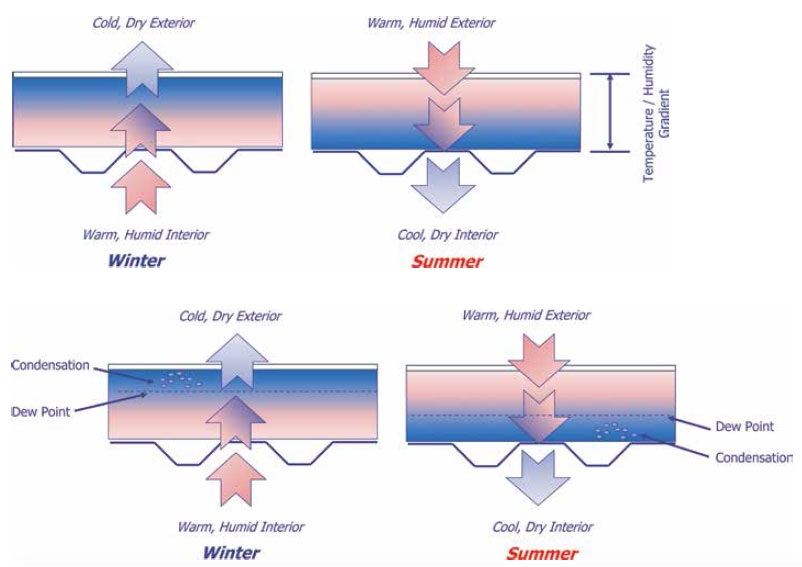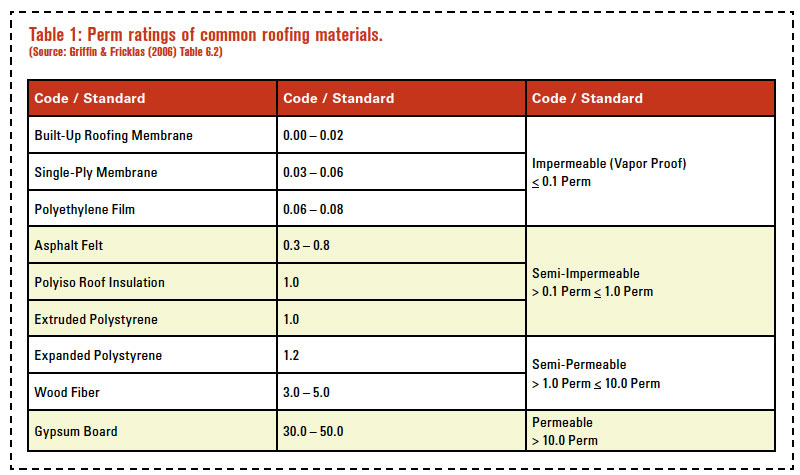Roofs and Condensation
Learning Objectives:
- Understand the basic principles behind vapor movement in roofing systems.
- Identify the key factors that may lead to moisture accumulation in roofing systems.
- Learn how to use available design tools to evaluate moisture movement in roofing systems.
- Identify design strategies to reduce the potential for moisture accumulation in roofing systems.
Credits:
The steady growth of modern single-ply roofing systems over the past 40 years generated many questions regarding long term performance. Early in their development, many of the questions were related to the capability of single-ply roofing systems to resist external forces such as wind, fire, ultraviolet radiation, and precipitation in all forms. However, with the advent of “cool” single-ply roofs featuring heat reflective exterior surfaces, new questions have emerged concerning the internal forces at play within the roofing system, especially in regard to vapor movement and the potential for moisture condensation within the roof.
Starting with a brief discussion of the fundamentals of vapor movement in roofing systems, this article reviews current research to gain an understanding of the actual incidence of moisture condensation and the key factors that may lead to the accumulation of moisture within single-ply roofing systems. Based on a review of recent experiments and field studies, the paper concludes that moisture condensation in all roofs is a relatively rare phenomenon that tends to occur only in the presence of one or more severe design conditions. These conditions include:
- Extremely cold external temperatures
- Extremely high internal temperatures and humidity
- Unusually low amounts of over-deck roof insulation
- Unusually high levels of air movement within the roofing system
The paper also provides a brief discussion of commonly available tools to analyze moisture in roofs, as well as the effect of air barriers and vapor retarders on moisture condensation. In regard to current moisture analysis tools, the paper suggests that these tools may overestimate the potential for moisture condensation in roofs due to the complexity and uncertainty of the variables required. In regard to vapor retarders, the paper suggests that their use involves a number of risks, including the potential for trapped moisture due to external roof leaks as well as reduced air movement within the roofing system to allow drying of the roof over time, commonly referred to as the “self-drying roof” concept.
Based on the review of moisture movement in roofing systems and the tools available to assess and mitigate roof condensation, the paper also provides suggestions for the roofing design professional to deal effectively with moisture movement. These suggestions include:
- Establish a conservative but realistic estimate for actual interior humidity conditions within the building.
- Limit unnecessary air movement within the roofing system — both in the design of the roof and in the quality of roof installation.
- Include a minimum amount of above deck thermal insulation beneath the roofing membrane.
- Allow whenever possible the capability of the roof to “self-dry” in the event condensation does occur.
- Select roofing materials with low perm ratings and high resistance to moisture damage.
- Use modeling tools, but recognize their limitations.
Introduction
Over the past 40 years, a dramatic transformation has occurred within the commercial roofing industry. From the beginnings of modern commercial construction methods until the last quarter of the 20th century, commercial rooftops were dominated by a single roofing technology: built-up roofing frequently referred to as “tar and gravel” roofs. Beginning in the 1970s, however, a variety of new single-ply roofing technologies emerged to challenge traditional built-up roofing practice. These single-ply systems experienced strong and continuous growth, and by the end of the 20th century, they dominated commercial roofing to the same extent previously enjoyed by built-up roofing.
Compared to built-up roofs, single-ply roofs offered a number of advantages. Single-ply roofs generally require less field labor to install, and the labor conditions themselves are less demanding. Single-ply roofs also tend to be more accommodating to the higher levels of thermal insulation required by today’s energy codes, and their lower overall weight allows for economies in the structural design of the underlying roof deck. Due to these and other advantages, single-ply roofs now account for over three-quarters of the commercial roofing market (Tegnos Research, 2012).
As with any significant change in construction practice, the move to single-ply roofing generated questions regarding long-term performance. Early in the development of single plies, most of these questions were related to the capability of these new roofing systems to resist external forces such as wind, fire, ultraviolet, and precipitation in all forms. As a result of these and other concerns, single-ply roofing manufacturers made significant investments in product development and testing, which have produced achievements in wind, fire, and weathering performance.
Recently, new questions have been raised regarding the ability of single-ply roofs to resist internal forces within the roofing system, especially air and vapor movement. Some of these questions are related to the use of mechanical attachment of single-ply membranes, which may allow additional air movement within the roof. Other questions are related to the increasing use of “cool,” or highly reflective single-ply membranes in regard to the potential for vapor condensation beneath such membranes and within the roofing system.
In response to these concerns, this paper provides a review of current research in order to understand the actual incidence of moisture condensation in single-ply roofs and to identify the key factors that may lead to the accumulation of moisture within these roofing systems. The paper also discusses the role of related technologies, such as air barriers and vapor retarders, to control moisture condensation in single-ply roofs. Finally, the paper discusses the role of available building physics modeling tools to help the roofing professional avoid the potential for condensation in roof systems.
Roofs and Moisture: Key Principles
Before reviewing the research evidence about moisture condensation in roofs, it is important to discuss the complex interplay between roofs and moisture. Such a review can be complicated, especially in terms of the underlying factors; but much of this complexity may be summarized in a few key principles to help guide design decisions.
The science is simple, but the factors are complex.
The basic science of condensation is straightforward and well-established. Moisture in the form of water vapor tends to move from a warm, humid condition to a cold, dry condition as the result of the process of diffusion. Due to diffusion, water vapor tends to move from a warm, humid interior of a building to a colder, less humid external environment. This inside-to-outside water vapor movement is typical for buildings during the winter months, especially in the colder regions of North America. Conversely, in the summer in many North American climates, this vapor movement via diffusion is reversed, with water vapor moving from a warm, humid exterior to a cooler and less humid interior. Figure 1 illustrates this typical winter and summer diffusion of water vapor within a roofing system.

(TOP) Figure 1: Winter and Summer roof vapor drive
(BOTTOM) Figure 2: Winer and summer roof dew point condition

Even though this dew point condition may be reached occasionally during the summer in the southernmost climates in North America, the occurrence of condensation in roofing systems is more commonly observed during the winter in the northernmost climates (Griffin & Fricklas, Chap. 6). As a consequence, the findings and recommendations of this article are focused primarily on the potential for roof condensation to occur during the winter heating season, especially in colder climate regions.
Although a theoretical dew point may be calculated based on simple measures of temperature and humidity within a roofing system, there are several important factors that help determine the exact conditions for condensation and the extent that such condensation occurs. First, the rate of vapor drive is affected by the indoor humidity of the entire building (See Figure 1), which may vary widely depending on type of occupancy and function. While large retail and wholesale storage facilities may rarely exceed 30 to 40 percent relative humidity (RH) in the winter, other occupancies, such as heavy manufacturing and indoor swimming pools, may approach 75 to 90 percent RH (See Griffin & Fricklas, 2006, Table 6.4.). As a result, occupancy tends to play a much more important factor in predicting the potential for condensation than either the indoor or outdoor temperature.
Next, the rate of vapor drive is affected by the permeability of the materials within a roofing system, as measured by their perm rating. As defined by current industry standards (ASTM E-96), the higher the perm rating number, the more readily water vapor (in the gaseous state) can be absorbed and move through the material. Table 1 provides a listing of common roofing materials and compares their perm ratings.
For materials with perm ratings less than 0.1, very little if any vapor can be absorbed or transferred. As shown in Table 1, almost all roofing membranes as well as plastic films such as polyethylene are considered to be impermeable to water vapor. For materials with slightly higher perm ratings between 0.1 and 1.0, the rate of vapor absorption and transfer is significantly reduced, especially if the temperature/humidity gradient is not severe. Examples of semi-impermeable roofing materials include individual layers of roofing felt and foam insulations such as extruded polystyrene and polyisocyanurate. For materials with perm ratings above 1.0, the rate of vapor absorption and transfer begins to increase, and such materials tend to absorb relatively large quantities of water whenever they are subjected to temperature/ humidity conditions below the dew point. Examples of common semi-permeable and permeable roofing materials include wood and mineral fiber boards, as well as many gypsum products.
In addition to the rate at which water vapor may transfer through a material, the effect of that transfer on the physical integrity of the material may vary significantly. Under some conditions, materials that may absorb moisture to some degree may be suitable for direct exposure to dew point conditions because the condensing moisture has little or no affect on the integrity of the material. One of the best examples of a less-than fully impermeable roofing product intentionally exposed to dew point conditions is the use of extruded polystyrene in inverted roof systems, where the foam insulation is directly exposed to both rain and condensation. Other foam insulations like polyisocyanurate also have low perm ratings, but the use of facers that can be distorted by moisture makes such materials less resistant to overall condensation and other effects.
At the opposite end of the perm spectrum, products with relatively high perm ratings tend to absorb significant quantities of moisture. And frequently, this high level of moisture absorption is associated with significant loss of material integrity. As a result, some common semipermeable and impermeable roofing products such as wood and mineral fiber will effectively be ruined when exposed to prolonged moisture condensation.
So far we have only discussed the movement of water vapor due to diffusion, but there is one additional and very important physical force that drives moisture movement. That force is the movement of air itself within a roofing assembly. And the effect of air movement on moisture transfer can be very significant. In a recent study of the effects of air movement versus diffusion (Lstiburek, 2004) the researcher demonstrated that air movement through a small inch square hole in a 4-foot by 8-foot gypsum board panel may drive almost 100 times as much water vapor than would move through the same panel due to diffusion. Although the effects of air movement in this study were related to wall assemblies, the finding of a relatively high level of vapor movement via a relatively small discontinuity in the wall assembly suggest that similar conditions in roofing systems may trigger similar high levels of moisture movement.










